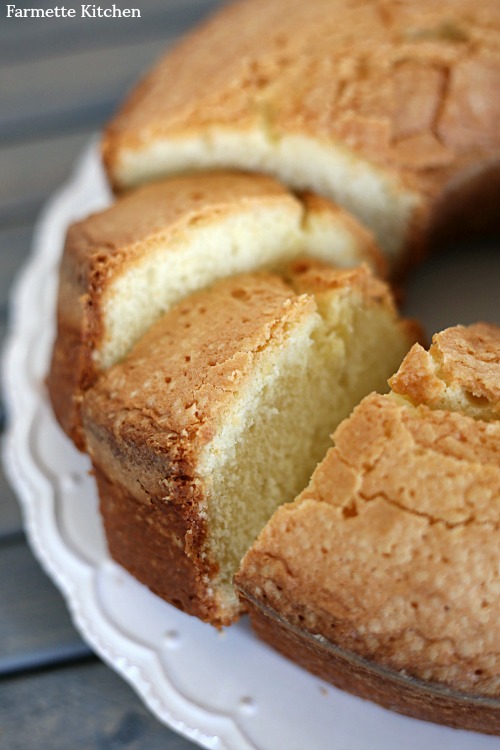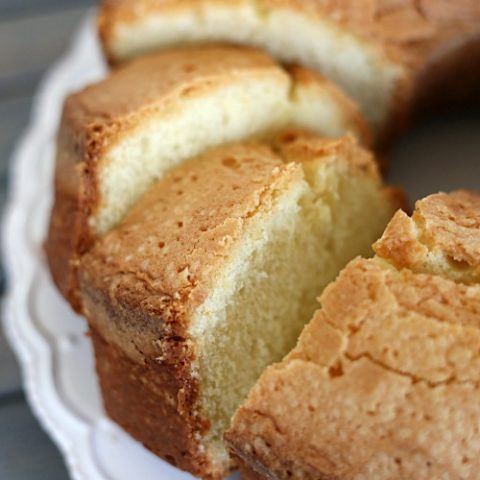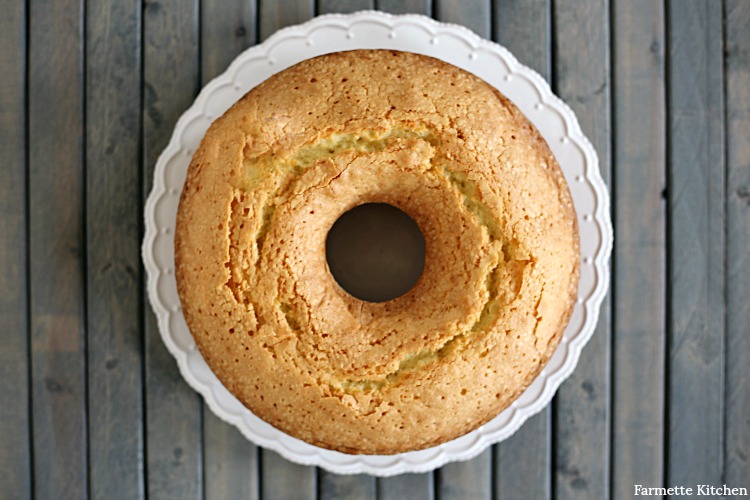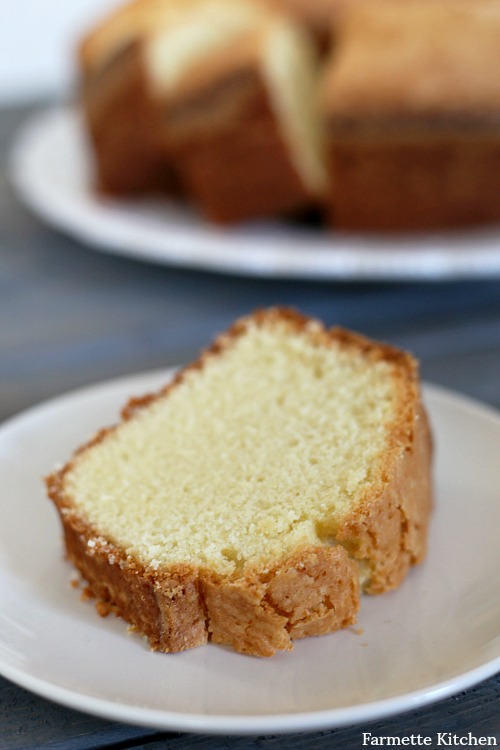This Old Fashioned Pound Cake recipe is one my mother made often throughout my childhood. Dense and buttery, this traditional pound cake is the perfect blank canvas for a fruit glaze or whipped topping.
My mom is forever making treats for my dad to take with him to work. She switches it up regularly between his favorite M&M cookies and various other sweets, like these Salted Caramel Blondies or her Classic Peanut Butter Cookies, but this Old Fashioned Pound Cake might be the most popular choice. The dense cake holds up well in a sack lunch and retains its smooth, buttery flavor for days.

True Pound Cake, or Traditional Pound Cake, is a recipe that dates back to the 1700s. It gets its name from its simple ingredients. Originally, the recipe called for one pound each of flour, sugar, butter, and eggs.
Throughout the years that recipe has been amended to include spices and flavorings such as vanilla, lemon, or almond extract. Some even include dairy (such as buttermilk or sour cream) or additional leavening agents (like baking soda or baking powder). My mom's Old Fashioned Pound Cake includes real vanilla extract for added depth of flavor.
Tips for the Perfect Pound Cake
- Use softened butter. You should be able to pick up the stick of butter and bend it without it melting in your fingers or becoming glistening or sticky. If the butter is too soft, it won't be able to hold the tiny pockets of air created during the creaming process that will eventually expand during cooking and help to lighten the cake.
- Use room-temperature eggs. Eggs are the only leavening agent used in traditional pound cakes and are important to incorporate air into the batter that will later expand in the oven and cause the cake to rise.
- Do not overbeat the batter. Overbeating the butter can soften it too much, making it greasy, which will diminish its ability to trap air. Overbeating the eggs whips in too much air and creates tunnels in the finished cake. Overbeating once the flour has been added promotes gluten formation and toughens the cake.
Pound cake batter should be a beautiful, pale-yellow emulsion. A well-emulsified batter will trap and hold air bubbles that then expand during baking. This produces the rise and is a major factor in the final texture of the cake.
A cake baked from a poorly emulsified batter will be grainy and uneven and can sink. If your emulsion breaks you might see what looks like curds or weeping. If this happens, try gently adding flour one tablespoon at a time until the texture recovers.
Before Baking the Pound Cake
The cardinal sin of baking pound cakes is not properly preparing your pan. Always grease cake pans with solid vegetable shortening, such as Crisco, and always dust with flour—a slippery surface keeps the batter from rising to its full volume.
This is the exact tube pan for pound cakes that I use- be sure to choose one that has a light colored interior.
While the Pound Cake is Baking
Resist the urge to take the pound cake out of the oven too soon. You want to place the cake pan in the center of the oven and keep the door closed until the minimum baking time has elapsed. If the cake requires more baking, gently close the oven door as soon as possible after testing to prevent jarring and loss of heat—both can cause a cake to fall if it’s not done.
After the Pound Cake is Finished Baking
Always allow the cake to cool in the pan, right side up, for about 10-15 minutes before attempting to remove it from the pan. It should still be warm but not hot. Cooling too long in the pan will cause the cake to be damp and stick to the pan. Remove the pound cake from pan to a wire rack and let cool completely.
A pound cake is the perfect "company" dessert because of its simplicity. I almost always have the ingredients on hand and it doesn't require any fussy frosting. It can be further embellished with a simple lemon or orange zest glaze, or topped with strawberries and homemade whipped cream, both of which can be made ahead of time.
Serve this classic pound cake with this fresh fruit salad for a quick and easy dessert!

Old Fashioned Pound Cake
This Old Fashioned Pound Cake recipe is one my mother made often throughout my childhood. Dense and buttery, this traditional pound cake is the perfect blank canvas for a fruit glaze or whipped topping.
Ingredients
- 1 cup unsalted butter, softened, (2 sticks)
- 2 cups all-purpose flour
- 2 cups granulated sugar
- 6 large eggs (room temperature)
Instructions
- Preheat the oven to 350 degrees.
- Grease and flour a tube pan.
- Cream the butter and sugar. The mixture should be light in color, like a pale yellow.
- Add the eggs one at a time. Continue to mix until the egg disappears completely into the mixture.
- Slowly incorporate the flour into the mixture one ½ cup at a time.
- Bake for 60 minutes or until an inserted toothpick comes out clean.
- Allow to cool in the pan 10-15 minutes. Remove from pan to a wire rack and let cool completely.
Notes
If adding vanilla extract, use 1 teaspoon.
Nutrition Information:
Yield: 12 Serving Size: 12 peopleAmount Per Serving: Calories: 371







Amy
Great tips! I love pound cake.
Sandy
I put Carriebean Rum and vanilla, and Mac nuts? We’ll see how it comes out! Love rum cake!??
Yvonne Lofton
I used Asbach Brandy and vanilla to give some flavor, since I substituted plain old lard for butter. The cooks I grew up with always made pound cake with lard...same with biscuits.
Tam
What kind of flour to us?
Emily Bruno
All-purpose
Sarah
Why don't recipes say what kind of flour? I have never made a pound cake. Thanks for asking. All Purpose Flour
Lyssa
If a recipe doesn’t say what kind of flour I usually just assume they mean all purpose.
Kat
Vanilla flavoring?
Emily Bruno
Vanilla extract
Glenda Farris
How do I add sour cream? Or can I add to this particular recipe?
Emily Bruno
Hi Glenda, I don't use sour cream in this recipe so I'm not sure how much you would need.
SafariiJava
Yes you can use sour cream in this recipe! You can add 1/2 cup
Afeefa
Hi Emily, Your cake looks yummy and though I have baked pound cakes before, have never tried a version without baking powder or baking soda
I am planning to make your pound cake today and wanted to ask you if I could use an 8 inch square aluminium baking pan instead of a bundt pan. Thanks.
Emily Bruno
Hi, I've never tried that! I'm worried it would be too small.
Pam Tyrone
Salted or unsalted butter?
Emily Bruno
I used unsalted
Betty King
you don't have the amount of vanilla extract to use. Please let me know asap I am making this tomorrow. Thanks so much! Betty
Emily Bruno
Hi Betty, the vanilla is optional. I would use 1 teaspoon. Hope this helps!
Suzanne
This looks so good! I love that the ingredient list is so simple and pound cake is so versatile. You can serve with a few options!
Vanessa
Thanks for sharing! Does it keep long?
Kimberley Spraggins
Hi! This recipe looks very easy. What size tube pan to use, 10 or 12 cup? I find most pound cake recipes don't specify. It would really help. Can't wait to try your Gramma's recipe! My go-to is Betty Crocker's pound cake recipe.
Emily Bruno
Hi Kimberley, I believe mine is actually a heavier 16 cup shown in the pictures, but a 12 cup would also work!
Ann Garrity
I used to make a pound cake like yours, with no leavening agents, but lost my recipe after years of not baking desserts. . A quick search led me to your site. I tried your recipe yesterday and it came out perfectly to my liking!
I actually made cupcakes which I gave away to neighbors as "Poundcake Mini's" .
I've printed your recipe and will make it again soon. Thank you so much for your website, Emily!
NickiDE
How long did you bake the pound cake minis?
Kathleen
This recipe was so easy to follow and my cake tasted delicious! I did use the vanilla extract in mine and we topped with strawberries. I will definitely be making this again.
Angelica
I have made this several times. Today I decided to add cocoa to it and make it a chocolate pound cake and it was so good. Thank you for sharing!
Dana Thomas
Wonderful pound cake. Just like I like them with a crusty top. I added almond extract! Smells great!
Paula Mason
How much cocoa
Najia
Hello. Mt question is no baking powder. Without baking powder.?
Emily Bruno
Correct- the eggs are the leavening agent. No baking powder necessary.
Mary
This sounds like my husbands moms cake that I have been trying to duplicate for years. I have not mastered it yet! He keeps talking about the holes in the cake which I know from reading is air pockets. You said not to over beat the eggs or batter. Is there a certain time for beating the eggs and batter? I don’t have a large mixer. I don’t think I will ever duplicate it like hers, but maybe I can get close. I wanted to make it for his birthday. Hope for you to reply soon.
Emily Bruno
Hi Mary- the time will depend on your mixer and ingredients, but it should be a couple of minutes at least. The batter will turn a pale yellow color. I hope this helps and I hope your husband loves the cake!!
James Tyndall
Hi my name is James Tyndall I wanted to let you know that I cooked one of your old fashioned pound cakes today and its awesome
Terry's Journey
Just made it, and I tasted it right out of the oven, yum!!!!
I have been struggling to make gluten-free pound cake for years. Either the flavor was not right, or it did not rise as it should or it was just plain awful. Just made this recipe with my favorite gluten-free flour and it just hit the perfect note. Good thing I made 3 loafs because I am certain hubby will finish one by the end of the day today.
Jett W
No milk? I guess the 6th egg would take the place of that.
I've been baking pound cakes for many years and never baked one without milk. I'm curious to see what this one turns out like.
Sue Fraser
By far the easiest and BEST pound cake I have ever made/had. Love the simplicity of this recipe… loved it! Thank you!!
Tomika Parker
I love the simplicity of the ingredients. It turned out great but I could taste the eggs a little more than I like. Is there anyway to use less eggs or substitute some of them with something else?
Catherine
Thank you - Thank you - Thank you -
An actual pound cake recipe! I run a gluten free bakery and this was perfect right out of the gate. That never really happens, it often takes a few times to get a gluten free product exactly right, but, being an authentic pound cake recipe - everything worked beautifully. Very delicious, Very amazing. I did add vanilla extract to help the flavor, but I am thinking of trying it without it just to see how it goes.
Again, thank you for making my search easier. I remember a lb cake is literally a lb for the 4 ingredients. This was the kind of recipe I was looking for.
Emily Bruno
So happy you enjoyed it!
Dana H McCarthy
What gluten free flour is everyone's favorite?
Emily Bruno
I like Bob's Red Mill 1-to-1
Judy
My grandmother made these every holiday & always made fruit salad made from fresh fruit to have along side. She used nutmeg instead of vanilla. They smelled & tasted so good. She was still doing this every year until she passed at 97 years old. Such good memories!
Emily Bruno
Nutmeg sounds lovely! 97 years- how special! Thank you for sharing 🙂
Nicole Tefera
Am I able to use a Bundt cake pan?
Stephanie
Can I use a loaf pan?
Emily Bruno
Hi Stephanie, I haven't tried that. Please let me know how it goes!
Carol in Memphis
Tied this recipe and it was my first attempt making a pound cake. Came out beautifully and was so yummy!!!! Thank you!!!!
Mary A. Hansen
Has anyone tried making this recipe with half the sugar??
Carol in Memphis
Hi, the first pound cake I ever made and was so proud of myself!!! This recipe is so easy and is the pound cake is absolutely delicious! Thanks for sharing!!!
Emily Bruno
You're welcome, Carol! 🙂 So happy you enjoyed it!
Patricia P
Yes Mary, i just did and it came out great and tasty.
Thanks for this recipe, Emily
Brittany B
I made this today, using a 12 cup bundt pan. I also measured using a scale. This cake is delicious!!!
I used these measurements:
2 sticks of butter or 8 oz
8.8 oz of sugar
6.8 oz of organiz all purpose flour
2 oz of Eichorn flour
6 room temperature eggs
It turned out beautifully. So delicious 😋